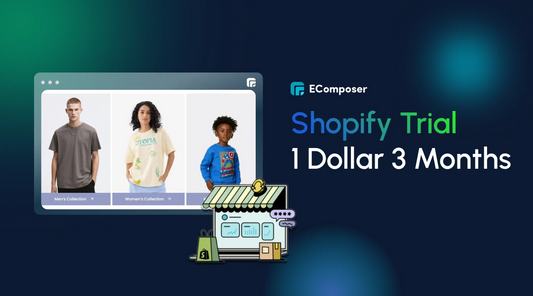How to Sell Digital Products on Shopify? 2025 Guide

Table Of Contents
Selling digital products on Shopify is a game-changer for entrepreneurs seeking to maximize profits. Digital products offer advantages like low overhead costs, scalability, and automation. This guide supplies practical tips to navigate the process and unlock your digital product's potential.
What is a digital product?
A digital product is an intangible item that is delivered electronically or accessed online, such as software, e-books, music, videos, courses, templates, and other downloadable or streaming content. These products are not physical goods but rather digital files or assets that can be purchased, downloaded, or accessed via the internet.
Types of Digital Products
- E-books: These digital publications encompass a broad spectrum of content, ranging from captivating fiction novels to informative instructional guides. They offer readers a convenient and portable way to access written material on various topics, catering to diverse interests and knowledge seekers. E-books often provide in-depth insights, tutorials, stories, or information packaged in a digital format that can be easily downloaded, read, and stored across devices.
- Software: This category encapsulates a myriad of digital solutions, including applications, plugins, or tools tailored to address specific challenges or enhance user experiences. From productivity software simplifying daily tasks to complex applications powering industries, software products cater to varied needs. Plugins augment functionalities within existing platforms, offering added features or customization options.
- Online courses: These digital educational materials provide structured learning experiences on diverse subjects, covering everything from academic topics to specialized skills. They offer a flexible and accessible way for learners to acquire knowledge or develop skills through video lectures, quizzes, assignments, and interactive content. Online courses cater to a global audience, allowing learners to access high-quality education from experts regardless of geographical constraints.
- Templates: These pre-designed layouts or formats serve as time-saving tools for individuals or businesses looking to create documents, websites, or graphics with ease. Templates offer a foundation or starting point, providing ready-made structures that users can customize to suit their specific needs. They come in various forms, such as website templates simplifying web design, document templates expediting report creation, or graphic design templates aiding in visual content creation.
Advantages of Selling Digital Products
- - Low Production Costs: Minimal expenses compared to physical products; production often involves creation and distribution.
- - Scalability: Ability to sell limitless copies without worrying about inventory, production, or shipping constraints.
- - Instant Delivery: Immediate customer access upon purchase, enhancing user satisfaction and convenience.
How to Sell Digital Products on Shopify
Step 1: Choose your digital products for sale

It's essential to select the right product that aligns with your target market's needs and interests:
- Conduct market research to identify popular niches and trends.
- Consider your expertise and passion, as this will help you create a valuable and unique product that stands out from the competition.
- Harnessing your expertise and passions amplifies this process, enabling you to craft a product that not only aligns with market demands but also embodies your unique insights and perspectives. Your personal investment in the product's creation adds an authentic touch, resonating deeply with your audience.
- Focus on delivering a product that solves a problem or fulfills a desire. Ensure that your digital product provides clear benefits and stands out as a high-quality offering in the market.
- Ensuring its superiority in quality, whether through unique features, enhanced user experience, or added value components, distinguishes it from competitors and solidifies its place as a premium offering in the market.
Step 2: Setting Up an Appealing Shopify Store

Choose a theme that is suitable to your brand identity and showcases your digital products effectively. Consider factors like responsiveness, customization options, and compatibility with various devices to ensure a seamless user experience.
A responsive theme that adapts seamlessly across various devices is vital for reaching and engaging a wider audience. Customizing options allow you to tailor the design to align with your brand's look and feel, enhancing recognition and fostering a cohesive experience for visitors.
Pro Tips: Merchants may customize page types and parts using EComposer Page Builder, including the checkout page. Retailers may enhance checkout page performance, aesthetics, and usefulness using built-in extensions and speed-up tools. Revenues and conversions may rise.

Compelling product descriptions and high-quality images are key to capturing customers' attention and convincing them to make a purchase. Craft persuasive and informative product descriptions that highlight the unique benefits and benefits of your digital products.
Quality images serve as visual cues, enticing customers and adding credibility to your offerings. This combination not only informs but also entices, nudging visitors toward making informed purchase decisions, so incorporating website design elements to create a successful store.
Simplifying the checkout process is imperative for reducing cart abandonment rates. Create a one-page checkout that is easy to use to ensure a safe and hassle-free transaction experience.
Offering multiple payment options caters to diverse customer preferences while clear instructions guide users seamlessly through the purchase journey.
Instilling confidence in your store's security through trust badges and SSL certificates reassures customers about the safety of their sensitive information, fostering trust and encouraging completed purchases.
Enhancing your store's visibility and driving organic traffic requires strategic optimization. Conducting thorough keyword research empowers you to identify and incorporate relevant terms into your product titles, descriptions, and meta tags, enhancing discoverability.
Regularly updating content, coupled with a robust blogging strategy, not only enriches your store's content but also boosts its SEO performance, increasing the opportunity of ranking higher in search engine results.
Step 3: Integrate your digital products into Shopify and enhance their pages

- Install “Digital Downloads" in Shopify apps store.
- Now, proceed to include your digital products. Within your Shopify admin panel, navigate to Apps, choose Digital Downloads, and select “Add new product”.
- Next, choose "Add your products."
- Before entering product details, in the Shipping section, ensure to uncheck the option indicating "This product requires shipping." This notifies Shopify that you're vending a digital item.
- Subsequently, input all pertinent details, encompassing:
- Title
- Description
- Product images
- Product category
- Pricing
- Save your changes upon completion. To upload digital files for your item, revisit your admin panel. Access Digital Downloads under Apps.
- Select “Add digital files”.

- You can either drag and drop files into this area or click the Add files button provided.

- Remember, there's a maximum file size limit of 5GB. Additionally, by clicking Fulfillment, you can adjust how your product is delivered, either through automatic or manual file transmissions.
- At this stage, you can opt for automatic or manual file delivery and set download restrictions. Once done, click “Save”.
Step 4: Implementing Effective Marketing Strategies

Utilizing social media as a marketing tool involves more than just having a presence; it's about strategic engagement. Selecting platforms that resonate most with your target audience is paramount. Knowing the online platforms where your potential customers are active allows you to concentrate your efforts where they will have the greatest influence.
Leveraging social media advertising further amplifies your reach. Through targeted campaigns, you can precisely aim at specific demographics, interests, or behaviors, ensuring your digital products are showcased to those most likely to be interested.
The dynamic nature of social media platforms also Enables engaging directly with customers, nurturing connections, and gathering valuable feedback that can inform product improvements or marketing strategies.
Pricing strategy is a delicate balance between value perception and profitability. Conducting thorough market research is crucial for determining the optimal pricing for your digital products.
Consideration of production costs, competitor pricing, and perceived value in the market landscape guides this decision-making process. Offering competitive prices that align with market standards while highlighting the unique value proposition of your products ensures a compelling proposition for customers.
Furthermore, incentive and promotion strategies such as limited-time offers, discounts, or bundled deals can incentivize purchases, driving sales and enhancing customer satisfaction.
Collaborating with influencers or affiliates can significantly expand your product's reach and credibility. Leveraging their influence through sponsored content, reviews, or affiliate partnerships can expose your digital products to a wider audience.
This collaborative approach not only extends your reach but also leverages the established trust between the influencer/affiliate and their audience, potentially leading to increased conversions and sales.
Step 5: Managing and Fulfilling Digital Product Orders

Automating the order fulfillment process within your Shopify store streamlines operations and enhances customer satisfaction. Integrating a dependable digital product delivery platform or plugin seamlessly connects your store to an automated system.
This setup enables the instantaneous delivery of purchased digital products upon successful payment, ensuring a swift and hassle-free experience for customers. Automating this process not only saves time but also mitigates the risk of errors in manual delivery, offering a consistent and reliable service to your buyers.
Security is paramount when delivering digital products. Implement robust measures to safeguard your products from unauthorized access or piracy.
Utilize encryption methods, secure download links, or digital rights management (DRM) tools to protect your digital assets. Conduct rigorous testing of the delivery process to guarantee that customers receive their purchased products promptly and without any technical glitches.
A seamless and secure delivery process not only instills confidence in customers but also safeguards your products against potential piracy or unauthorized distribution.
Efficient handling of customer inquiries and support regarding orders is pivotal for a positive customer experience. You can use Product Feedback Tools, which are not mere feedback collectors but catalysts for growth, innovation, and creating products that authentically connect with your audience.
Provide crystal-clear instructions for accessing and utilizing your digital products, ensuring customers encounter no confusion or difficulty. Establishing a dedicated support system—be it through email, live chat, or a ticketing system—allows you to promptly solve customer inquiries and resolve any issues they encounter.
Proactively gather and assess customer feedback to pinpoint areas of concern or areas for improvement. Incorporating this feedback into refining your support mechanisms and product instructions enriches the overall customer experience, fostering satisfaction and loyalty among your clientele.
Step 6: Analyzing and Optimizing Profitability

Tracking sales and revenue through robust analytics tools within your Shopify store is pivotal for gauging the performance of your digital product offerings.
Leveraging these tools provides comprehensive insights into various key performance indicators (KPIs) crucial for understanding your business's health. Metrics such as total sales, average order value, and customer lifetime value offer valuable insights into the overall performance and financial gains of your digital products. By monitoring these KPIs, you gain a clearer understanding of customer behavior and purchasing patterns, enabling you to make informed strategic decisions.
Analyzing revenue trends over time unveils crucial patterns and trends integral to optimizing your digital product strategy. Examining data trends helps identify peak sales periods, seasonal fluctuations, or product-specific performance variations.
For instance, recognizing which products perform exceptionally well during specific seasons allows you to capitalize on these trends through targeted marketing or inventory adjustments. Moreover, understanding which products contribute the most to customer lifetime value aids in refining your product offerings to maximize profitability.
Step 7: Building Customer Relationships and Loyalty

Developing a loyalty program is an effective strategy to incentivize repeat purchases and referrals, fostering a deeper connection with your customer base. Implement a tiered loyalty system where customers earn points or rewards for each purchase or successful referral.
Exclusive access to premium content is a compelling way to elevate the value proposition for loyal customers. Offer them access to specialized resources like advanced e-books, in-depth tutorials, or exclusive webinars that aren't accessible to regular buyers.
Encouraging customer reviews and referrals: Utilize social media channels to prompt customers to share their experiences and recommend your products to their own audience.
Develop a mailing list by providing valuable content discounts in exchange for customers' email addresses. Send personalized and targeted email campaigns to foster relationships with customers. There are many apps that support email campaigns, so take advantage of them.
5 Tips on Selling Digital Products

- Emphasizes the importance of identifying your niche when selling digital products.
Understanding your target audience is crucial. It involves researching and comprehending the specific interests, needs, and pain points of a particular group of people. By doing so, you can create digital products that cater directly to those needs or solve particular problems that audience faces.
For instance, if you're considering creating an online course, identifying a niche involves understanding what skills or knowledge your audience desires or lacks. It could be a specialized skill within a broader field or a specific demographic with unique requirements.
By focusing on a niche, you can create more tailored, relevant, and valuable digital products. This approach increases the likelihood of attracting a dedicated audience that sees your product as a solution uniquely crafted for their needs, potentially leading to higher engagement, sales, and customer satisfaction.
- Underscores the significance of maintaining high quality in your digital products.
For any digital offering—whether it's an ebook, software, artwork, course, or any other form of digital content—ensuring a high standard of quality is paramount. Quality directly influences the perceived value of your product.
Customers are more likely to invest in, appreciate, and recommend digital products that offer substantial value, whether through informative content, impeccable design, or exceptional functionality. High-quality products not only satisfy customers but also increase the likelihood of positive reviews and repeat purchases.
Maintaining quality involves thorough editing, proofreading, or refining content to ensure accuracy and relevance. In the case of software or digital tools, it means ensuring seamless functionality and user-friendly interfaces. Additionally, appealing aesthetics, intuitive navigation, and engaging content all contribute to a product's quality.
By prioritizing and consistently delivering high-quality digital products, you can build a reputation for excellence, establish trust with your audience, and differentiate yourself from competitors in the market. This, in turn, can lead to increased customer loyalty and a stronger brand presence.
- Revolves around crafting an effective marketing strategy to promote and sell your digital products.
An effective marketing plan is crucial for ensuring your digital products reach the right audience. Here are some key components:
Targeted Promotion: Identify the most suitable channels to reach your audience. Utilize social media platforms, content marketing (like blogs or videos), email marketing, SEO (Search Engine Optimization), and paid advertising to showcase your digital products.
Engagement: Engage with your audience authentically. Use compelling storytelling, interactive content, or behind-the-scenes glimpses to create a connection. Respond promptly to inquiries and feedback to foster a sense of community.
Influencer or Affiliate Collaborations: Partner with influencers or affiliates in your niche to expand your reach. Their endorsement or promotion of your digital products can significantly boost visibility and credibility.
Clear Messaging: Craft compelling and clear messaging that highlights the unique value proposition of your digital products. Communicate how your products solve problems or meet specific needs, compelling potential customers to make a purchase.
Analytics and Optimization: Continuously monitor your marketing efforts' performance using analytics tools. Adjust your strategies based on data insights to optimize your campaigns for better results.
A well-structured marketing strategy not only drives visibility and sales but also helps build brand awareness and loyalty. It's about creating a consistent presence across various channels while resonating with your target audience.
- Emphasizes the importance of providing excellent customer support when selling digital products.
Even in the digital realm, customer support remains a crucial aspect of the overall experience. Here's why it matters:
Accessibility: Ensure customers can easily reach out for assistance if they encounter issues with purchasing or accessing your digital products. Offer multiple contact options such as email, live chat, or a dedicated support portal.
Timely Responses: Respond promptly to customer inquiries or concerns. Swift and helpful responses demonstrate your commitment to customer satisfaction and can prevent dissatisfaction or negative reviews.
Guidance and Assistance: Provide clear instructions for accessing and using your digital products. Create user-friendly guides, FAQs, or tutorials that assist customers in navigating any potential hurdles they might face.
Feedback and Improvement: Encourage feedback from customers to understand their experiences and areas where your products or support can improve. Use this input to refine your offerings and enhance the overall customer experience.
Post-Purchase Engagement: Maintain engagement even after the purchase. Follow up with customers, provide additional resources or updates related to the product, and create a community where customers can share experiences or ask questions.
Exceptional customer support builds trust, fosters loyalty, and encourages repeat purchases. It also plays a role in building a positive reputation for your brand, as satisfied customers are more likely to recommend your products to others.
- Ensure your digital products remain updated and innovative.
Feedback Collection: Regularly gather feedback from customers about their experiences, pain points, and suggestions for improvement. This can be done through surveys, reviews, or direct communication channels.
Scheduled Updates: Plan regular updates or releases for your digital products. Set a schedule for implementing new features, fixing bugs, or enhancing existing functionalities based on the feedback received.
Innovation Research: Stay informed about industry trends, technological advancements, and changes in customer preferences. Allocate time for research and development to explore new ideas that could add value to your products.
Testing and Quality Assurance: Before rolling out updates or innovations, conduct thorough testing to ensure they work as intended and don’t introduce new issues. Quality assurance is crucial to maintain the integrity of your products.
Clear Communication: Inform your customers about updates, new features, or improvements. Use newsletters, social media, or dedicated communication channels to let them know about the changes and how it benefits them.
Customer Involvement: Sometimes, involving customers in the innovation process can be beneficial. Consider beta testing or early access programs where customers can provide feedback on new features before a full release.
Continuous Iteration: The process of updating and innovating is ongoing. Regularly revisit your products, gather fresh feedback, and iterate based on the evolving needs and preferences of your customers.
By following these steps and integrating a culture of continuous improvement into your digital product development cycle, you can ensure that your offerings remain relevant, valuable, and appealing to your audience.
Learn more:
- Best Shopify Digital themes
- How to Add Digital Products on Shopify
- Top 12 Shopify Digital Download Apps
Wrap Up
In conclusion, by choosing the right products, setting up an appealing store, implementing effective marketing strategies, managing orders efficiently, and building strong customer relationships, you can make your digital product business reach its full potential.
Now is the time to take action and start implementing these strategies to drive sales, increase profitability, and achieve success on Shopify. Don't wait; get started today and watch your profits soar.






















0 comments